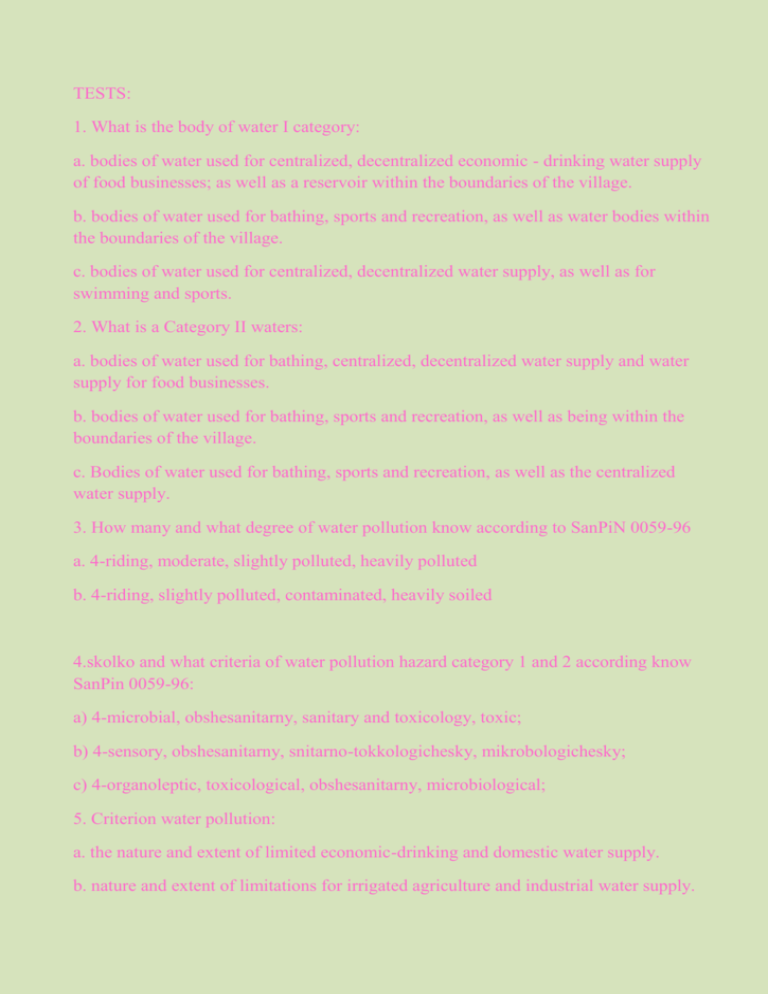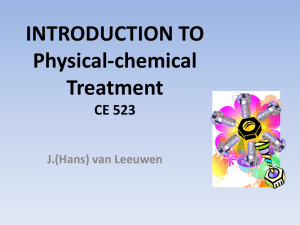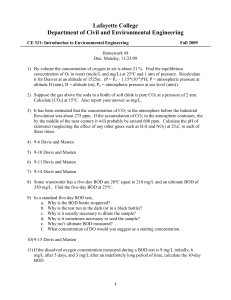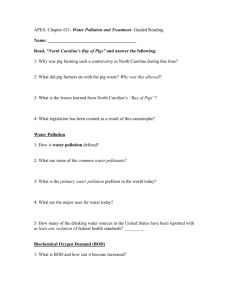tests- тесты
advertisement

TESTS: 1. What is the body of water I category: a. bodies of water used for centralized, decentralized economic - drinking water supply of food businesses; as well as a reservoir within the boundaries of the village. b. bodies of water used for bathing, sports and recreation, as well as water bodies within the boundaries of the village. c. bodies of water used for centralized, decentralized water supply, as well as for swimming and sports. 2. What is a Category II waters: a. bodies of water used for bathing, centralized, decentralized water supply and water supply for food businesses. b. bodies of water used for bathing, sports and recreation, as well as being within the boundaries of the village. c. Bodies of water used for bathing, sports and recreation, as well as the centralized water supply. 3. How many and what degree of water pollution know according to SanPiN 0059-96 a. 4-riding, moderate, slightly polluted, heavily polluted b. 4-riding, slightly polluted, contaminated, heavily soiled 4.skolko and what criteria of water pollution hazard category 1 and 2 according know SanPin 0059-96: a) 4-microbial, obshesanitarny, sanitary and toxicology, toxic; b) 4-sensory, obshesanitarny, snitarno-tokkologichesky, mikrobologichesky; c) 4-organoleptic, toxicological, obshesanitarny, microbiological; 5. Criterion water pollution: a. the nature and extent of limited economic-drinking and domestic water supply. b. nature and extent of limitations for irrigated agriculture and industrial water supply. c. the degree of restriction of drinking and industrial water use. 6. What are the indicators obespechivayushie normal course of self-purification: a. BOD, dissolved oxygen, water temperature increased responsiveness b. BOD, dissolved oxygen, active reaction, painting c. BOD, coloring, odor, mineralization 7. The circumstances under which it is prohibited to throw in the waste water reservoirs: a. which can be eliminated by rationalizing technology use in recycling, water novatornogo for orascheniya in agriculture. b. which can be eliminated sanitation, support activities, chemical, mechanical and chemical methods of proper c. which can be eliminated by rationalizing technology satitarno-technical, support activities, self-chemical methods 8. Do not release wastewater: a. substance in quantities prevyshayushih established standards of technological losses and waste water with an unpleasant odor b. substance in quantities, at the level of the established norms of technological losses, drains an unpleasant odor, highly mineralized. c. substance in quantities prevyshayushih established standards of technological losses, radioactive substances, technological waste, substances for which no exposure limits. 9. What are the estimates for the pollution of water bodies 1 and category 2 know? a. smell, taste, color, suspended solids b. the smell, the color, suspended solids, COD c. smell, taste, MPC, org. Tox. 10. What are the performance indicators of water pollution category 1 u2 know? a. BOD, dissolved oxygen, the number of coliforms, the smell. b. BOD, dissolved oxygen, the number of coliforms, COD c. BOD, dissolved oxygen, painting, COD 1. Reservoirs Category II a) Water bodies ispolzuyumye for swimming and recreation sprota taken in RA, as well as the use of water bodies located within the boundaries of settlements. b) bodies of water used for water supply of the food industry. c) Water bodies are used as a source of centralized and de centralized water supply. d) water bodies used for fishery purposes. 2. Permissible temperature at the drinking water of a water body category II a) 250 b) 180 c) Do not be increased by more than 50 d) Do not be increased by more than 30 d) It shall be equal to the T to the pond water discharge. 3. The possibility of increasing the content of suspended solids in drinking water. category as compared with the water reservoir to water discharge. A) 0.5 mg / l b) 0.25 mg / l c) 1.5 mg / l g) HA1 mg / l d) 0.75 mg / l 4. The calculation formula for determining the allowable BOD wastewater. a) Fst = Qf / q (VLC-Cr) + VLC b) X = Qa + q / q c) Fst = 2,5Qa / q (Op-O-4Kr 4) -10 g) Fst = (Qa / q + 1) + Cr Kdop d) Fst = Qa / q (BOD BPKr) + BOD 5. indirect indicators otsustvija pathogens in drinking water reservoirs II category. a) Otsustvie pathogens in wastewater discharged to pond b) Koli-code 1000 in the waters of descent c) code 1000, Coley, if titer of 1.5 mg / L in sewage launchable g) Residual chlorine 10 mg / L in sewage launchable d) Koli-titer 300 in the descent wastewater 6. The point is not the flow of the water body, the composition and properties of water which must meet standards a) 1 km in both directions from point of water use. b) V1km above the nearest water puneta c) At the point of water discharge d) At the point of water d) Requirements predyavlyayutsya the most Wastewater 7. Permitted mineral composition of the water in the drinking water of 1 category a) 500 mg / l b) 1500mg / l c) 1000 mg / l g) Not rated d) 250 mg / l 8. In the water reservoir BOD 6mg / l, rostvorenny oxygen - 4 mg / l. Your opinion on the possibility of using the reservoir. a) The pond is suitable for drinking purposes b) in a reservoir high BOD and it is not suitable as a source of centralized water supply c) Pond meets the specification and can be used for bathing, sports d) In the pond dissolved oxygen does not meet the standards, and it is not suitable for drinking d) In the pond low BOD, it can not be used as a reservoir hozyaistvenno drinking and cultural and community water use. 9. The calculation formula for determining the permissible content of suspended solids in the wastewater a) Fst = Qf / q (BOD BPKr) + BPKdan b) X = Qa + q / q c) Fst = 2,5Qa / q (Op-O-4Kr 4) -10 g) Fst = (Qa / q + 1) + Cr Kdop d) Fst = Qa / q (VLC-Cr) + VLC 10. The smell and taste of water from the drinking water. waterbody 1 category a) 1 point b) 3 points c) 4 points g) 2 points d) 0 points






![Crisis Communication[1] - NorthSky Nonprofit Network](http://s2.studylib.net/store/data/005428035_1-f9c5506cadfb4c60d93c8edcbd9d55bf-300x300.png)